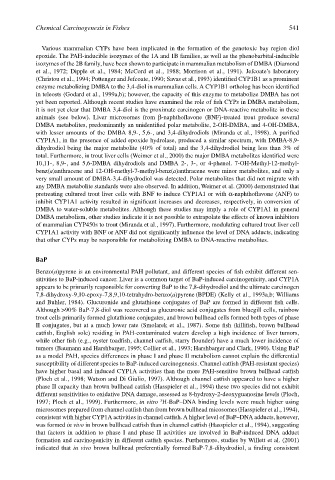Page 561 - The Toxicology of Fishes
P. 561
Chemical Carcinogenesis in Fishes 541
Various mammalian CYPs have been implicated in the formation of the genotoxic bay region diol
epoxide. The PAH-inducible isozymes of the 1A and 1B families, as well as the phenobarbital-inducible
isozymes of the 2B family, have been shown to participate in mammalian metabolism of DMBA (Diamond
et al., 1972; Dipple et al., 1984; McCord et al., 1988; Morrison et al., 1991). Jefcoate’s laboratory
(Christou et al., 1994; Pottenger and Jefcoate, 1990; Savas et al., 1993) identified CYP1B1 as a prominent
enzyme metabolizing DMBA to the 3,4-diol in mammalian cells. A CYP1B1 ortholog has been identified
in teleosts (Godard et al., 1999a,b); however, the capacity of this enzyme to metabolize DMBA has not
yet been reported. Although recent studies have examined the role of fish CYPs in DMBA metabolism,
it is not yet clear that DMBA 3,4-diol is the proximate carcinogen or DNA-reactive metabolite in these
animals (see below). Liver microsomes from β-naphthoflavone (BNF)-treated trout produce several
DMBA metabolites, predominantly an unidentified polar metabolite, 2-OH-DMBA, and 4-OH-DMBA,
with lesser amounts of the DMBA 8,9-, 5,6-, and 3,4-dihydrodiols (Miranda et al., 1998). A purified
CYP1A1, in the presence of added epoxide hydrolase, produced a similar spectrum, with DMBA-8,9-
dihydrodiol being the major metabolite (40% of total) and the 3,4-dihydrodiol being less than 3% of
total. Furthermore, in trout liver cells (Weimer et al., 2000) the major DMBA metabolites identified were
10,11-, 8,9-, and 5,6-DMBA dihydrodiols and DMBA 2-, 3-, or 4-phenol. 7-OH-Methyl-12-methyl-
benz(a)anthracene and 12-OH-methyl-7-methyl-benz(a)anthracene were minor metabolites, and only a
very small amount of DMBA-3,4-dihydrodiol was detected. Polar metabolites that did not migrate with
any DMBA metabolite standards were also observed. In addition, Weimer et al. (2000) demonstrated that
pretreating cultured trout liver cells with BNF to induce CYP1A1 or with α-naphthoflavone (ANF) to
inhibit CYP1A1 activity resulted in significant increases and decreases, respectively, in conversion of
DMBA to water-soluble metabolites. Although these studies may imply a role of CYP1A1 in general
DMBA metabolism, other studies indicate it is not possible to extrapolate the effects of known inhibitors
of mammalian CYP450s to trout (Miranda et al., 1997). Furthermore, modulating cultured trout liver cell
CYP1A1 activity with BNF or ANF did not significantly influence the level of DNA adducts, indicating
that other CYPs may be responsible for metabolizing DMBA to DNA-reactive metabolites.
BaP
Benzo(a)pyrene is an environmental PAH pollutant, and different species of fish exhibit different sen-
sitivities to BaP-induced cancer. Liver is a common target of BaP-induced carcinogenicity, and CYP1A
appears to be primarily responsible for converting BaP to the 7,8-dihydrodiol and the ultimate carcinogen
7,8-dihydroxy-9,10-epoxy-7,8,9,10-tetrahydro-benzo(a)pyrene (BPDE) (Kelly et al., 1993a,b; Williams
and Buhler, 1984). Glucuronide and glutathione conjugates of BaP are formed in different fish cells.
Although >90% BaP-7,8-diol was recovered as glucuronic acid conjugates from bluegill cells, rainbow
trout cells primarily formed glutathione conjugates, and brown bullhead cells formed both types of phase
II conjugates, but at a much lower rate (Smolarek et al., 1987). Some fish (killifish, brown bullhead
catfish, English sole) residing in PAH-contaminated waters develop a high incidence of liver tumors,
while other fish (e.g., oyster toadfish, channel catfish, starry flounder) have a much lower incidence of
tumors (Baumann and Harshbarger, 1995; Collier et al., 1993; Harshbarger and Clark, 1990). Using BaP
as a model PAH, species differences in phase I and phase II metabolism cannot explain the differential
susceptibility of different species to BaP-induced carcinogenesis. Channel catfish (PAH-resistant species)
have higher basal and induced CYP1A activities than the more PAH-sensitive brown bullhead catfish
(Ploch et al., 1998; Watson and Di Giulio, 1997). Although channel catfish appeared to have a higher
phase II capacity than brown bullhead catfish (Hasspieler et al., 1994) these two species did not exhibit
different sensitivities to oxidative DNA damage, assessed as 8-hydroxy-2-deoxyguanosine levels (Ploch,
3
1997; Ploch et al., 1999). Furthermore, in vitro H-BaP–DNA binding levels were much higher using
microsomes prepared from channel catfish than from brown bullhead micosomes(Hasspieler et al., 1994),
consistent with higher CYP1A activities in channel catfish. A higher level of BaP–DNA adducts, however,
was formed in vivo in brown bullhead catfish than in channel catfish (Hasspieler et al., 1994), suggesting
that factors in addition to phase I and phase II activities are involved in BaP-induced DNA adduct
formation and carcinogenicity in different catfish species. Furthermore, studies by Willett et al. (2001)
indicated that in vivo brown bullhead preferentially formed BaP-7,8-dihydrodiol, a finding consistent

